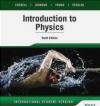Introduction to Physics
Kenneth Johnson, John Cutnell
Introduction to Physics
Kenneth Johnson, John Cutnell
- Producent: John Wiley
- Rok produkcji: 2015
- ISBN: 9781118651520
- Ilość stron: 896
- Oprawa: Miękka
Niedostępna
Opis: Introduction to Physics - Kenneth Johnson, John Cutnell
* Cutnell and Johnson has been the Number one text in the algebra-based physics market for over 20 years. Over 250,000 students have used the book as the equipment they need to build their problem-solving confidence, push their limits, and be successful. * The tenth edition continues to offer material to help the development of conceptual understanding, and show the relevance of physics to readers lives and future careers. * Helps the reader to first identify the physics concepts, then associate the appropriate mathematical equations, and finally to work out an algebraic solution1 Introduction and Mathematical Concepts 1.1 The Nature of Physics 1.2 Units 1.3 The Role of Units in Problem Solving 1.4 Trigonometry 1.5 Scalars and Vectors 1.6 Vector Addition and Subtraction 1.7 The Components of a Vector 1.8 Addition of Vectors by Means of Components 2 Kinematics in One Dimension 2.1 Displacement 2.2 Speed and Velocity 2.3 Acceleration 2.4 Equations of Kinematics for Constant Acceleration 2.5 Applications of the Equations of Kinematics 2.6 Freely Falling Bodies 2.7 Graphical Analysis of Velocity and Acceleration 3 Kinematics in Two Dimensions 3.1 Displacement, Velocity, and Acceleration 3.2 Equations of Kinematics in Two Dimensions 3.3 Projectile Motion 3.4 Relative Velocity 4 Forces and Newton s Laws of Motion 4.1 The Concepts of Force and Mass 4.2 Newton s First Law of Motion 4.3 Newton s Second Law of Motion 4.4 The Vector Nature of Newton s Second Law of Motion 4.5 Newton s Third Law of Motion 4.6 Types of Forces: An Overview 4.7 The Gravitational Force 4.8 The Normal Force 4.9 Static and Kinetic Frictional Forces 4.10 The Tension Force 4.11 Equilibrium Applications of Newton s Laws of Motion 4.12 Nonequilibrium Applications of Newton s Laws of Motion 5 Dynamics of Uniform Circular Motion 5.1 Uniform Circular Motion 5.2 Centripetal Acceleration 5.3 Centripetal Force 5.4 Banked Curves 5.5 Satellites in Circular Orbits 5.6 Apparent Weightlessness and Artifi cial Gravity 5.7 Vertical Circular Motion 6 Work and Energy 6.1 Work Done by a Constant Force 6.2 The Work Energy Theorem and Kinetic Energy 6.3 Gravitational Potential Energy 6.4 Conservative Versus Nonconservative Forces 6.5 The Conservation of Mechanical Energy 6.6 Nonconservative Forces and the Work Energy Theorem 6.7 Power 6.8 Other Forms of Energy and the Conservation of Energy 6.9 Work Done by a Variable Force 7 Impulse and Momentum 7.1 The Impulse Momentum Theorem 7.2 The Principle of Conservation of Linear Momentum 7.3 Collisions in One Dimension 7.4 Collisions in Two Dimensions 7.5 Center of Mass 8 Rotational Kinematics 8.1 Rotational Motion and Angular Displacement 8.2 Angular Velocity and Angular Acceleration 8.3 The Equations of Rotational Kinematics 8.4 Angular Variables and Tangential Variables 8.5 Centripetal Acceleration and Tangential Acceleration 8.6 Rolling Motion 8.7 The Vector Nature of Angular Variables 9 Rotational Dynamics 9.1 The Action of Forces and Torques on Rigid Objects 9.2 Rigid Objects in Equilibrium 9.3 Center of Gravity 9.4 Newton s Second Law for Rotational Motion About a Fixed Axis 9.5 Rotational Work and Energy 9.6 Angular Momentum 10 Simple Harmonic Motion and Elasticity 10.1 The Ideal Spring and Simple Harmonic Motion 10.2 Simple Harmonic Motion and the Reference Circle 10.3 Energy and Simple Harmonic Motion 10.4 The Pendulum 10.5 Damped Harmonic Motion 10.6 Driven Harmonic Motion and Resonance 10.7 Elastic Deformation 10.8 Stress, Strain, and Hooke s Law 11 Fluids 11.1 Mass Density 11.2 Pressure 11.3 Pressure and Depth in a Static Fluid 11.4 Pressure Gauges 11.5 Pascal s Principle 11.6 Archimedes Principle 11.7 Fluids in Motion 11.8 The Equation of Continuity 11.9 Bernoulli s Equation 11.10 Applications of Bernoulli s Equation 11.11 Viscous Flow 12 Temperature and Heat 12.1 Common Temperature Scales 12.2 The Kelvin Temperature Scale 12.3 Thermometers 12.4 Linear Thermal Expansion 12.5 Volume Thermal Expansion 12.6 Heat and Internal Energy 12.7 Heat and Temperature Change: Specific Heat Capacity 12.8 Heat and Phase Change: Latent Heat 12.9 Equilibrium Between Phases of Matter 12.10 Humidity 13 The Transfer of Heat 13.1 Convection 13.2 Conduction 13.3 Radiation 13.4 Applications 14 The Ideal Gas Law and Kinetic Theory 14.1 Molecular Mass, the Mole, and Avogadro s Number 14.2 The Ideal Gas Law 14.3 Kinetic Theory of Gases 14.4 Diffusion 15 Thermodynamics 15.1 Thermodynamic Systems and Their Surroundings 15.2 The Zeroth Law of Thermodynamics 15.3 The First Law of Thermodynamics 15.4 Thermal Processes 15.5 Thermal Processes Using an Ideal Gas 15.6 Specifi c Heat Capacities 15.7 The Second Law of Thermodynamics 15.8 Heat Engines 15.9 Carnot s Principle and the Carnot Engine 15.10 Refrigerators, Air Conditioners, and Heat Pumps 15.11 Entropy 15.12 The Third Law of Thermodynamics 16 Waves and Sound 16.1 The Nature of Waves 16.2 Periodic Waves 16.3 The Speed of a Wave on a String 16.4 The Mathematical Description of a Wave 16.5 The Nature of Sound 16.6 The Speed of Sound 16.7 Sound Intensity 16.8 Decibels 16.9 The Doppler Effect 16.10 Applications of Sound in Medicine 16.11 The Sensitivity of the Human Ear 17 The Principle of Linear Superposition and Interference Phenomena 17.1 The Principle of Linear Superposition 17.2 Constructive and Destructive Interference of Sound Waves 17.3 Diffraction 17.4 Beats 17.5 Transverse Standing Waves 17.6 Longitudinal Standing Waves 17.7 Complex Sound Waves 18 Electric Forces and Electric Fields 18.1 The Origin of Electricity 18.2 Charged Objects and the Electric Force 18.3 Conductors and Insulators 18.4 Charging by Contact and by Induction 18.5 Coulomb s Law 18.6 The Electric Field 18.7 Electric Field Lines 18.8 The Electric Field Inside a Conductor: Shielding 18.9 Gauss Law 18.10 Copiers and Computer Printers 19 Electric Potential Energy and the Electric Potential 19.1 Potential Energy 19.2 The Electric Potential Difference 19.3 The Electric Potential Difference Created by Point Charges 19.4 Equipotential Surfaces and Their Relation to the Electric Field 19.5 Capacitors and Dielectrics 19.6 Biomedical Applications of Electric Potential Differences 20 Electric Circuits 20.1 Electromotive Force and Current 20.2 Ohm s Law 20.3 Resistance and Resistivity 20.4 Electric Power 20.5 Alternating Current 20.6 Series Wiring 20.7 Parallel Wiring 20.8 Circuits Wired Partially in Series and Partially in Parallel 20.9 Internal Resistance 20.10 Kirchhoff s Rules 20.11 The Measurement of Current and Voltage 20.12 Capacitors in Series and in Parallel 20.13 RC Circuits 20.14 Safety and the Physiological Effects of Current 21 Magnetic Forces and Magnetic Fields 21.1 Magnetic Fields 21.2 The Force That a Magnetic Field Exerts on a Moving Charge 21.3 The Motion of a Charged Particle in a Magnetic Field 21.4 The Mass Spectrometer 21.5 The Force on a Current in a Magnetic Field 21.6 The Torque on a Current-Carrying Coil 21.7 Magnetic Fields Produced by Currents 21.8 Ampere s Law 21.9 Magnetic Materials 22 Electromagnetic Induction 22.1 Induced Emf and Induced Current 22.2 Motional Emf 22.3 Magnetic Flux 22.4 Faraday s Law of Electromagnetic Induction 22.5 Lenz s Law 22.6 Applications of Electromagnetic Induction to the Reproduction of Sound 22.7 The Electric Generator 22.8 Mutual Inductance and Self-Inductance 22.9 Transformers 23 Alternating Current Circuits 23.1 Capacitors and Capacitive Reactance 23.2 Inductors and Inductive Reactance 23.3 Circuits Containing Resistance, Capacitance, and Inductance 23.4 Resonance in Electric Circuits 23.5 Semiconductor Devices 24 Electromagnetic Waves 24.1 The Nature of Electromagnetic Waves 24.2 The Electromagnetic Spectrum 24.3 The Speed of Light 24.4 The Energy Carried by Electromagnetic Waves 24.5 The Doppler Effect and Electromagnetic Waves 24.6 Polarization 25 The Refl ection of Light: Mirrors 25.1 Wave Fronts and Rays 25.2 The Refl ection of Light 25.3 The Formation of Images by a Plane Mirror 25.4 Spherical Mirrors 25.5 The Formation of Images by Spherical Mirrors 25.6 The Mirror Equation and the Magnification Equation 26 The Refraction of Light: Lenses and Optical Instruments 26.1 The Index of Refraction 26.2 Snell s Law and the Refraction of Light 26.3 Total Internal Refl ection 26.4 Polarization and the Refl ection and Refraction of Light 26.5 The Dispersion of Light: Prisms and Rainbows 26.6 Lenses 26.7 The Formation of Images by Lenses 26.8 The Thin-Lens Equation and the Magnification Equation 26.9 Lenses in Combination 26.10 The Human Eye 26.11 Angular Magnifi cation and the Magnifying Glass 26.12 The Compound Microscope 26.13 The Telescope 26.14 Lens Aberrations 27 Interference and the Wave Nature of Light 27.1 The Principle of Linear Superposition 27.2 Young s Double-Slit Experiment 27.3 Thin-Film Interference 27.4 The Michelson Interferometer 27.5 Diffraction 27.6 Resolving Power 27.7 The Diffraction Grating 27.8 Compact Discs, Digital Video Discs, and the Use of Interference 27.9 X-Ray Diffraction 28 Special Relativity 28.1 Events and Inertial Reference Frames 28.2 The Postulates of Special Relativity 28.3 The Relativity of Time: Time Dilation 28.4 The Relativity of Length: Length Contraction 28.5 Relativistic Momentum 28.6 The Equivalence of Mass and Energy 28.7 The Relativistic Addition of Velocities 29 Particles and Waves 29.1 The Wave Particle Duality 29.2 Blackbody Radiation and Planck s Constant 29.3 Photons and the Photoelectric Effect 29.4 The Momentum of a Photon and the Compton Effect 29.5 The De Broglie Wavelength and the Wave Nature of Matter 29.6 The Heisenberg Uncertainty Principle 30 The Nature of the Atom 30.1 Rutherford Scattering and the Nuclear Atom 30.2 Line Spectra 30.3 The Bohr Model of the Hydrogen Atom 30.4 De Broglie s Explanation of Bohr s Assumption About Angular Momentum 30.5 The Quantum Mechanical Picture of the Hydrogen Atom 30.6 The Pauli Exclusion Principle and the Periodic Table of the Elements 30.7 X-Rays 30.8 The Laser 30.9 Medical Applications of the Laser 30.10 Holography 31 Nuclear Physics and Radioactivity 31.1 Nuclear Structure 31.2 The Strong Nuclear Force and the Stability of the Nucleus 31.3 The Mass Defect of the Nucleus and Nuclear Binding Energy 31.4 Radioactivity 31.5 The Neutrino 31.6 Radioactive Decay and Activity 31.7 Radioactive Dating 31.8 Radioactive Decay Series 31.9 Radiation Detectors 32 Ionizing Radiation, Nuclear Energy, and Elementary Particles 32.1 Biological Effects of Ionizing Radiation 32.2 Induced Nuclear Reactions 32.3 Nuclear Fission 32.4 Nuclear Reactors 32.5 Nuclear Fusion 32.6 Elementary Particles 32.7 Cosmology Appendices Appendix A Powers of Ten and Scientifi c Notation Appendix B Significant Figures Appendix C Algebra Appendix D Exponents and Logarithms Appendix E Geometry and Trigonometry Appendix F Selected Isotopes Answers to Check Your Understanding Answers to Odd-Numbered Problems Index
Szczegóły: Introduction to Physics - Kenneth Johnson, John Cutnell
Tytuł: Introduction to Physics
Autor: Kenneth Johnson, John Cutnell
Producent: John Wiley
ISBN: 9781118651520
Rok produkcji: 2015
Ilość stron: 896
Oprawa: Miękka
Waga: 2.04 kg






























